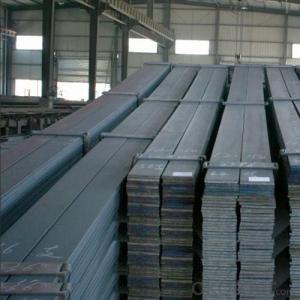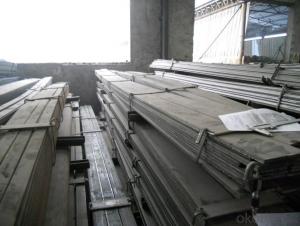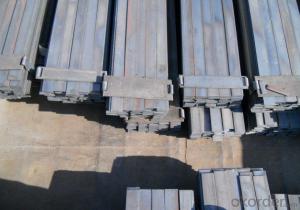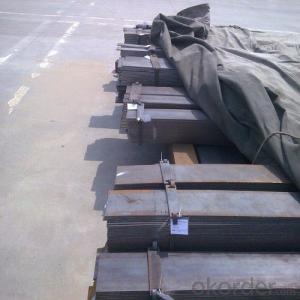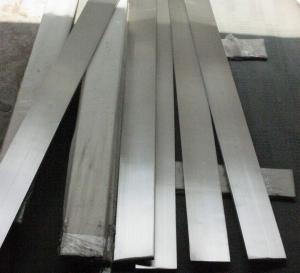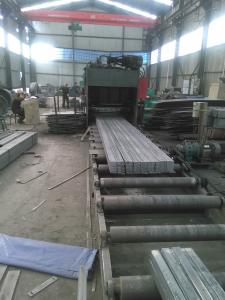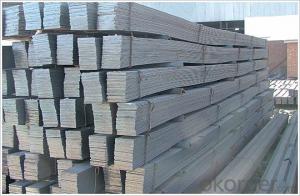Steel Flat Bar Supply 440C Stainless Flat Bar
- Loading Port:
- Tianjin
- Payment Terms:
- TT or LC
- Min Order Qty:
- 24 m.t.
- Supply Capability:
- 24000 m.t./month
OKorder Service Pledge
OKorder Financial Service
You Might Also Like
Product Description:
OKorder is offering Steel Flat Bar Supply 440C Stainless Flat Bar at great prices with worldwide shipping. Our supplier is a world-class manufacturer of steel, with our products utilized the world over. OKorder annually supplies products to European, North American and Asian markets. We provide quotations within 24 hours of receiving an inquiry and guarantee competitive prices.
Product Applications:
Steel Flat Bar Supply 440C Stainless Flat Bar are ideal for structural applications and are widely used in the construction of buildings and bridges, and the manufacturing, petrochemical, and transportation industries.
Product Advantages:
OKorder's Steel Flat Bar Supply 440C Stainless Flat Bar are durable, strong, and resist corrosion.
Main Product Features:
· Premium quality
· Prompt delivery & seaworthy packing (30 days after receiving deposit)
· Corrosion resistance
· Can be recycled and reused
· Mill test certification
· Professional Service
· Competitive pricing
Product Specifications:
Commodity: Mild Steel Flat Bar
Standard: GB;JIS
Material: Q195-235;SS400
Brand name: FLATSPACE
Origin place: China
Thickness: 3mm-30mm
Width:20mm-200mm
Length: Max 12m
Certification: SGS/BV
Chemical composition of Q235
Alloy No | Grade | Element(%) | ||||
C | Mn | S | P | Si | ||
Q235 |
B |
0.12—0.20 |
0.3—0.7 |
≤0.045 |
≤0.045 |
≤0.3 |
Packaging & Delivery of Hot Rolled Flat Bar Steel
1. Packing: it is nude packed in bundles by steel wire rod
2. Bundle weight: not more than 3.5MT for bulk vessel; less than 3 MT for container load
3. Marks:
Color marking: There will be color marking on both end of the bundle for the cargo delivered by bulk vessel. That makes it easily to distinguish at the destination port.
Tag mark: there will be tag mark tied up on the bundles. The information usually including supplier logo and name, product name, made in China, shipping marks and other information request by the customer.
If loading by container the marking is not needed, but we will prepare it as customer request.
4. Transportation: the goods are delivered by truck from mill to loading port, the maximum quantity can be loaded is around 40MTs by each truck. If the order quantity cannot reach the full truck loaded, the transportation cost per ton will be little higher than full load.
5. Delivered by container or bulk vessel
FAQ:
Q1: Why buy Materials & Equipment from OKorder.com?
A1: All products offered byOKorder.com are carefully selected from China's most reliable manufacturing enterprises. Through its ISO certifications, OKorder.com adheres to the highest standards and a commitment to supply chain safety and customer satisfaction.
Q2: How do we guarantee the quality of our products?
A2: We have established an advanced quality management system which conducts strict quality tests at every step, from raw materials to the final product. At the same time, we provide extensive follow-up service assurances as required.
Q3: How soon can we receive the product after purchase?
A3: Within three days of placing an order, we will begin production. The specific shipping date is dependent upon international and government factors, but is typically 7 to 10 workdays.
Q4: What makes stainless steel stainless?
A4: Stainless steel must contain at least 10.5 % chromium. It is this element that reacts with the oxygen in the air to form a complex chrome-oxide surface layer that is invisible but strong enough to prevent further oxygen from "staining" (rusting) the surface. Higher levels of chromium and the addition of other alloying elements such as nickel and molybdenum enhance this surface layer and improve the corrosion resistance of the stainless material.
Q5: Can stainless steel rust?
A5: Stainless does not "rust" as you think of regular steel rusting with a red oxide on the surface that flakes off. If you see red rust it is probably due to some iron particles that have contaminated the surface of the stainless steel and it is these iron particles that are rusting. Look at the source of the rusting and see if you can remove it from the surface.
Images:
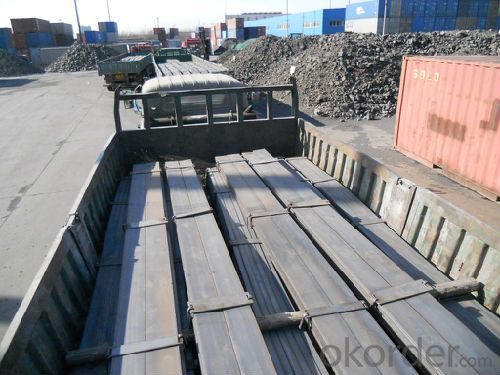
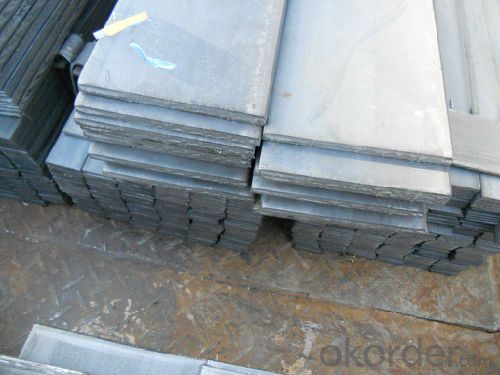

- Q:Are steel flat bars commonly used in the mining industry?
- Yes, steel flat bars are commonly used in the mining industry. Steel flat bars are versatile and durable, making them suitable for various applications in mining operations. They are commonly used for structural support, as well as in the construction of machinery and equipment used in mining. Steel flat bars provide strength and stability, making them ideal for withstanding heavy loads and harsh environmental conditions commonly found in mining sites. Additionally, steel flat bars can be easily fabricated and customized to meet specific requirements, making them a popular choice in the mining industry.
- Q:How do steel flat bars compare to other types of steel profiles?
- Steel flat bars have several advantages over other types of steel profiles. Firstly, their flat shape makes them ideal for use in applications where strength and stability are important, such as in construction and manufacturing. The flat surface also allows for easy attachment and welding, making them versatile and easy to work with. Compared to other steel profiles, such as round bars or square bars, flat bars have a larger surface area, which can contribute to better load distribution. This makes them suitable for applications that require even weight distribution, such as in bridges or platforms. Additionally, steel flat bars have a uniform thickness throughout their length, unlike other profiles that may have varying thicknesses. This uniformity ensures consistent strength and structural integrity, making flat bars reliable and predictable in their performance. Furthermore, steel flat bars are often more cost-effective than other profiles due to their simpler manufacturing process. They can be produced in large quantities and require less machining, resulting in lower production costs. This affordability makes them a popular choice for various industries. However, it is important to note that the choice of steel profile depends on the specific requirements of the application. While steel flat bars offer many advantages, other profiles may be more suitable in certain situations. Factors such as load-bearing capacity, aesthetics, and ease of installation should be considered when determining the most appropriate steel profile for a particular project.
- Q:How do you clean and maintain steel flat bars?
- Achieving cleanliness and upkeep for steel flat bars can be accomplished by implementing a series of straightforward steps. To commence, begin by eliminating any loose dirt or debris present on the bars' surface. This undertaking can be achieved by employing either a brush or a cloth. Subsequently, concoct a cleaning solution by blending mild soap or dish detergent with warm water. It is advisable to avoid the utilization of harsh chemicals or abrasive cleansers, as they possess the potential to inflict harm upon the steel. Immerse a soft cloth or sponge into the soapy water and proceed to gently scrub the surface of the flat bars. Thoroughly clean both sides, as well as the edges. In the event that stubborn stains or rust spots are encountered, a non-abrasive cleaner specifically formulated for stainless steel may be employed. Administer the cleaner to the affected regions and scrub diligently using a soft brush or cloth. Post-cleaning, it is imperative to thoroughly rinse the flat bars with clean water, thus eradicating any residual soap. In order to maintain the steel flat bars, it is recommended that they be dried in their entirety subsequent to cleaning, thereby preventing the occurrence of water spots or rust formation. This can be accomplished by employing either a clean towel or allowing them to air dry naturally. Additionally, it is advantageous to apply a thin coating of mineral oil or stainless steel polish to the bars' surface. This will serve to safeguard the steel from oxidation and maintain its lustrous appearance. In order to forestall further deterioration, it is advised to regularly inspect the flat bars for signs of corrosion or damage. Should any issues be detected, prompt attention should be given to mitigate their impact. By adhering to these cleaning and maintenance practices, the steel flat bars can be preserved in optimal condition, thus extending their lifespan.
- Q:Can steel flat bars be coated with anti-slip materials?
- Coating steel flat bars with anti-slip materials is indeed possible. There are multiple techniques and substances accessible for achieving an anti-slip surface on steel flat bars. One commonly utilized substance is a non-slip epoxy coating that incorporates aggregates like aluminum oxide or silicon carbide. These aggregates generate a rough texture that improves grip and prevents slips or falls. Moreover, materials such as rubber, vinyl, or adhesive tapes with anti-slip characteristics can also be employed to enhance the slip resistance of steel flat bars. These coatings prove advantageous in locations where slip hazards may arise, such as walkways, ramps, stairs, or industrial environments. Applying anti-slip materials to steel flat bars in the appropriate manner ensures heightened safety and minimizes the likelihood of accidents across various settings.
- Q:What are the common surface treatments for steel flat bars?
- There are several common surface treatments for steel flat bars that are used to enhance their appearance, durability, and resistance to corrosion. These treatments include: 1. Hot-dip galvanizing: This process involves immersing the steel flat bars in a bath of molten zinc, which creates a protective zinc coating on the surface. Galvanizing provides excellent corrosion resistance and can extend the lifespan of the steel flat bars. 2. Powder coating: Powder coating involves applying a dry powder to the surface of the steel flat bars and then heating it to create a durable, protective finish. This treatment offers a wide range of colors and provides excellent resistance to scratching, chipping, and fading. 3. Electroplating: Electroplating is a process in which a thin layer of metal, such as zinc, nickel, or chrome, is deposited onto the surface of the steel flat bars using an electric current. This treatment improves the appearance of the bars, enhances their corrosion resistance, and can provide a decorative finish. 4. Painting: Painting is a common surface treatment for steel flat bars, where a layer of paint is applied to the surface to provide both aesthetic appeal and protection against corrosion. Various types of paints, including epoxy, polyurethane, and enamel, can be used depending on the specific application requirements. 5. Anodizing: Anodizing is mainly used for aluminum, but it can also be applied to steel flat bars. This process involves creating an oxide layer on the surface of the metal through electrolysis, which enhances corrosion resistance and provides a decorative finish. These surface treatments for steel flat bars are widely used in various industries, including construction, automotive, manufacturing, and infrastructure projects. The choice of treatment depends on the specific requirements of the application, such as desired aesthetics, durability, and corrosion resistance.
- Q:Can steel flat bars be used for making brackets or supports for telecommunications equipment?
- Yes, steel flat bars can be used for making brackets or supports for telecommunications equipment. Steel is a strong and durable material that can provide the necessary structural support for telecommunications equipment. Flat bars are particularly suited for this purpose as they can be easily fabricated and shaped into the desired bracket or support design. Moreover, steel flat bars have excellent load-bearing capabilities, making them suitable for holding the weight and ensuring stability of the equipment. Additionally, steel is resistant to environmental factors such as corrosion and can withstand harsh conditions, making it a reliable choice for telecommunications equipment brackets or supports.
- Q:Can steel flat bars be used for support brackets or frames?
- Steel flat bars have the capability to serve as support brackets or frames. Renowned for their exceptional strength and durability, they are exceptionally well-suited for offering structural support. In a plethora of applications, be it constructing buildings, manufacturing furniture, or even in the automotive or aerospace sectors, steel flat bars can be employed to fabricate brackets or frames. Their remarkable load-bearing capacity and resistance to bending render them dependable and robust choices for support brackets or frames. Furthermore, they possess versatility and can be effortlessly welded, drilled, or machined to meet precise design specifications.
- Q:Can steel flat bars be used in automotive applications?
- Yes, steel flat bars can be used in automotive applications. They are commonly used in various parts of automobiles such as brackets, frames, supports, and reinforcements due to their strength, durability, and ability to withstand high loads and impact.
- Q:Can steel flat bars be used for support beams or columns?
- Yes, steel flat bars can be used for support beams or columns. Steel flat bars are commonly used in construction and engineering projects for their strength and durability. They can provide structural support and stability when properly designed and installed.
- Q:Do steel flat bars have a specific yield strength?
- Yes, steel flat bars have a specific yield strength. The yield strength of a steel flat bar refers to the amount of stress it can withstand before it starts to deform permanently. This property is typically specified by manufacturers and can vary depending on the type and grade of steel used.
1. Manufacturer Overview |
|
|---|---|
| Location | |
| Year Established | |
| Annual Output Value | |
| Main Markets | |
| Company Certifications | |
2. Manufacturer Certificates |
|
|---|---|
| a) Certification Name | |
| Range | |
| Reference | |
| Validity Period | |
3. Manufacturer Capability |
|
|---|---|
| a)Trade Capacity | |
| Nearest Port | |
| Export Percentage | |
| No.of Employees in Trade Department | |
| Language Spoken: | |
| b)Factory Information | |
| Factory Size: | |
| No. of Production Lines | |
| Contract Manufacturing | |
| Product Price Range | |
Send your message to us
Steel Flat Bar Supply 440C Stainless Flat Bar
- Loading Port:
- Tianjin
- Payment Terms:
- TT or LC
- Min Order Qty:
- 24 m.t.
- Supply Capability:
- 24000 m.t./month
OKorder Service Pledge
OKorder Financial Service
Similar products
New products
Hot products
Hot Searches
Related keywords


